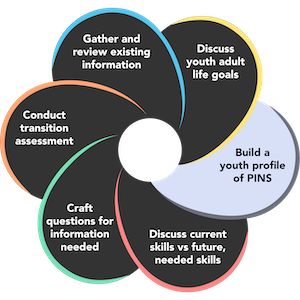Age-Appropriate Transition Assessment Planning Guide
Key Takeaways

Keep the conversation positive. Many times, our focus for students with disabilities is on their deficits. Let the conversation about the youth's profile focus on their interests, preferences, and strengths/skills. After all, this is the bulk of the PINS acronym!
Be sure we are including all team members and all forms of current, relevant transition assessment data (formal and informal). For example, if the youth participates in extracurricular activities, vocational training, related services, etc., all of those staff supporting the youth may have information on the youth's PINS or even how prepared they may be for their adult life goals.
Finally, each time we complete or update the youth's profile it is important to remember it is just a moment in time. Our hope is that future transition assessment continues to fill in gaps, confirm interests, or develop new preferences, interests, and skills/strengths. Be sure to continue to update the profile as new activities, experiences, maturation, and assessments are experienced for the youth.
